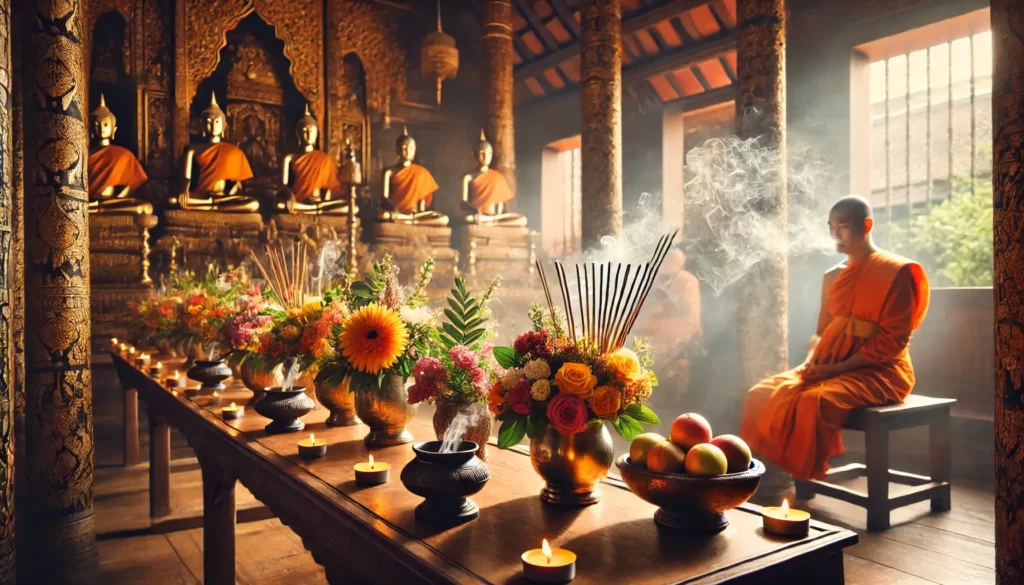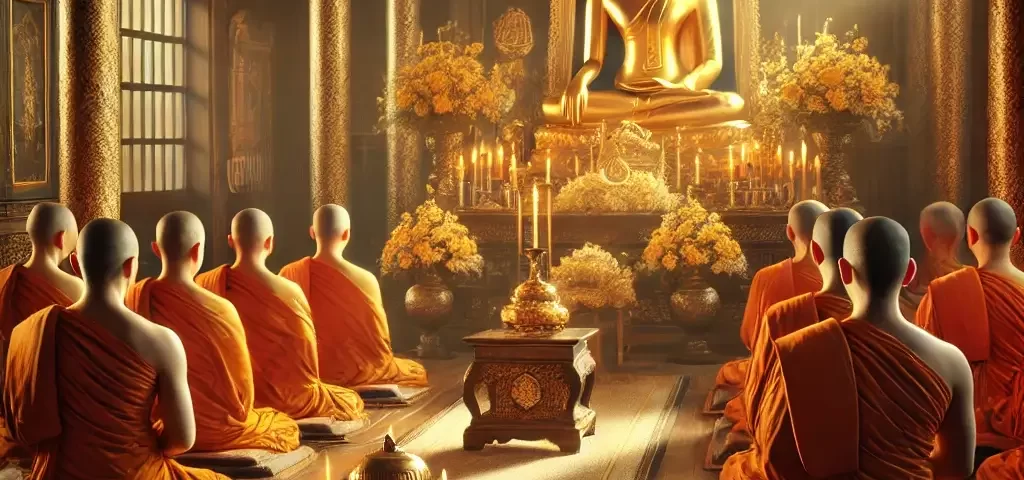Buddhist Funeral Traditions

Mormon Funeral Services
March 24, 2025
Hindu Funeral Rites
March 24, 2025Buddhism is a faith that instructs us that death is not the end but a transformation. The manner in which an individual leaves this world is of profound spiritual importance, determining his or her passage into the next. Buddhist funeral practices revolve around compassion, respect, and leading the deceased to a good rebirth. These are different across various traditions of Buddhism, but central assumptions regarding impermanence, karma, and rebirth inform the rites and rituals.
The Significance of Funerals in Buddhism
Buddhist funerals have a dual function—remembering the deceased and facilitating their journey toward enlightenment. Monks, relatives, and members of the community gather to generate a peaceful and merit-generating atmosphere. Chants, prayers, and gifts contribute to amassing good karma, facilitating an easy transition into the hereafter.
In contrast to the many Western cultures in which funerals are about closure, Buddhist funerals are about detachment and acceptance. Grief is recognized, but excessive mourning is frowned upon, as it can slow down the deceased’s journey toward rebirth. Rather, families direct their feelings into acts of merit, like donations and prayers, to help their loved one’s soul.
Core Beliefs About Death and Reincarnation
Reincarnation is the center of Buddhist death teaching. Existence is a repetitive cycle of life known as samsara in which animals are reborn in accordance with their karma—the sum of their acts from past lives. The character of the next life relies on stored karma, thus death becomes crucial to religious practice.
Buddhists hold that consciousness does not cease at death but proceeds toward rebirth. The 49-day interval following death is especially significant, as the soul passes through various states. Prayers and rituals during this time facilitate a peaceful transition into a positive rebirth. Each tradition has its own interpretation of these stages, but the underlying principle is the same: leading the deceased to a higher plane through good works and spiritual commitment.
Overview of Common Funeral Practices
Though customs vary according to region and sect, some aspects are uniform in Buddhist funerals. Chanting, prayers, and offerings are crucial, all intended to facilitate the deceased’s passage. Monks usually preside over ceremonies, reciting sacred scriptures to create positive energy. Families also contribute through merit-making activities, such as giving to temples or providing food for monks.
The most prevalent practice is cremation, in keeping with the Buddhist principle of impermanence. Burial is also practiced in some cultures, particularly in Chinese and Japanese Buddhism. Mourning practices differ, but the 49-day cycle is important in most sects, with memorial rites being conducted at intervals to keep producing merit for the deceased.
Key Elements of a Buddhist Funeral
Chanting and Prayers
Purpose: Guiding the Soul Toward Rebirth
Chanting connects the two lives, offering teachings and consolation for the deceased. Monks chant sacred sutras, such as Amitabha Sutra or Heart Sutra, reaffirming teachings on the fleeting nature and illumination of life. Chanting is believed to purify bad karma so that the dead may smoothly enter the afterlife.
Role of Monks and Family Members
Monks take the lead, guiding prayers and providing spiritual guidance. Relatives are also involved, chanting and earning merit for the benefit of their loved ones. In certain traditions, relatives might even take vows or undergo temporary monastic ordination as a means of respecting the deceased and creating positive karma.
Offerings and Rituals
Food, Flowers, and Incense as Symbols of Respect
Offerings show gratitude and respect. Food signifies liberality, while flowers indicate the fleeting nature of life. Incense, which is commonly burnt during the ceremony, symbolizes cleansing thoughts and is also an offering spiritually.
Dana (Charity) to Monks and the Poor
Dana, or giving, is a part of Buddhist funerals. Food, clothes, and money are donated by families to monks and the needy, passing merit to the deceased. Generosity is not only done for the dead but also develops compassion and detachment in the living.
The path after death is the focus of Buddhist philosophy, and thus funeral rites are a rich expression of spiritual faith. Every tradition, be it a chant, an offering, or act of charity, has a deeper purpose—pushing the soul onward while reminding the living of the transience of life.

Variations in Buddhist Funeral Practices
Theravāda Buddhism (Southeast Asia) – Focus on Merit-Making
Tiravāda practices focus on merit accumulation on behalf of the deceased to support their rebirth. Monks recite scripture, and households practice charity in the form of donations to monasteries. Cremation is practiced widely, although there is some practice of burial among communities. Ceremonies are conducted at regular intervals, with specific ceremonies held on the seventh and 49th days after death, in addition to anniversary remembrance rites.
Mahāyāna Buddhism (China, Korea, Japan) – Chanting and Ancestor Veneration
Mahāyāna Buddhists feel that chanting assists the soul in finding a good rebirth. Monks are invited by families to conduct these rituals, usually preceded by recitation of the Amitabha Sutra or Lotus Sutra. Ancestor worship is also an important aspect, with families keeping altars and offering gifts to remember their deceased relatives. Cremation and burial are both practiced, though they differ in terms of usage.
Vajrayāna Buddhism (Tibet, Mongolia) – Sky Burial and Elaborate Rituals
The Vajrayāna tradition includes specific funerary rites, such as the sky burial where the body is left on a mountaintop to be consumed by birds as an example of detachment and compassion. Elaborate ceremonies are done by the monks with the use of the Bardo Thodol (Tibetan Book of the Dead), which helps guide the soul through its process. Mandalas, butter lamps, and prayer flags are also employed in creating merit for the deceased spirit.
Buddhist Funeral Etiquette: What to Expect
Proper Dress Code and Behavior
Visitors should dress modestly, using somber colors like white or gray, which are seen as symbols of mourning in Buddhist culture. Black is avoided in most Asian societies because it is linked with Western mourning practices and not with Buddhist practice. Noisy, flashy clothing with much jewelry or ornamentation should be avoided.
How to Show Respect During the Ceremony
It is important to observe silence and be respectful in demeanor. Bowing in front of the altar, monks, or the picture of the deceased expresses respect. Visitors should join in chanting or meditation if invited but are not required to do so. It is appropriate to bring offerings, like incense or flowers, as a sign of respect.
Role of Non-Buddhist Attendees
Buddhist funerals can be attended by non-Buddhists and are welcome to follow general etiquette. It is beneficial to know the spiritual nature of the ceremony to offer appropriate respect. While non-Buddhists are not obliged to follow each ritual, standing in silence, offering condolences, and respecting cultural practices are well received.
Modern Adaptations of Buddhist Funerals
Eco-Friendly and Contemporary Funeral Practices
Sustainability has also become a growing concern, so increasingly, Buddhist communities have adopted eco-friendly funeral options. Tree-planting ceremonies, biodegradable urns, and natural burials are all aligned with Buddhist philosophies about impermanence and living in harmony with nature. Some monasteries have introduced digital memorial services to facilitate distant participation by far-off family members in ceremonies.
Buddhist Funeral Customs in the West
Western Buddhist funeral customs generally combine classic with modern changes. Memorial rites are performed at Buddhist centers and monasteries for various types of groups. Non-Buddhists can also participate by being invited on their own level of comfort, and inclusivity is encouraged. Online tributes and video-transmitted ceremonies are common so tradition can be kept intact despite in-person gatherings.
Conclusion
Buddhist funeral rites show deep reverence for the religious path of the deceased. Rituals, chanting, and merit-making bring consolation to both the deceased and his family. Funeral customs continue to develop, with the incorporation of modern elements amidst an enduring allegiance to core Buddhist tenets. Respect for the deceased through sympathy and mindfulness still form the fulcrum of these sacred practices.


